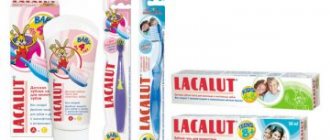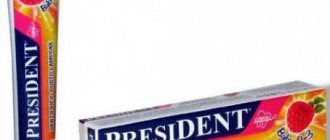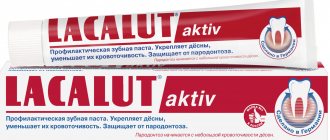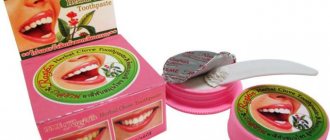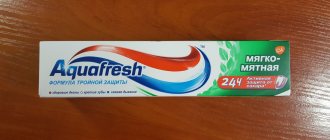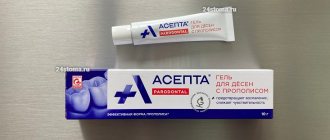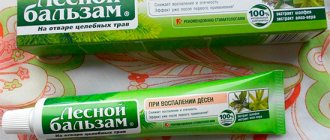From this article you will learn:
- instructions for use, reviews,
- price for Asepta gel in pharmacies,
- differences in composition between Asepta gel and balm.
The article was written by a dentist with more than 19 years of experience.
Asepta gum gel is a dental preparation in gel form used to treat inflammation of the oral mucosa and gums. This drug is the only gel for gums in Russian pharmacies, whose active component is a beekeeping product - propolis. It should be noted that this drug is not registered as a “drug” and therefore it belongs only to the “parapharmaceutical” category.
The drug is produced in Russia. Inside the cardboard package (in addition to the tube with the gel) there is a plastic spatula intended for applying the gel to the gums. You may feel a little weird at first when using this applicator to apply gel to your gums, but it actually does a better job than using your finger. In addition to Asepta gel, there is also ASEPTA in the form of an adhesive balm. This drug no longer contains propolis, but a combination of the antibiotic metronidazole and the antiseptic chlorhexidine.
ASEPTA in the form of gel and balm for gums: photo
Asepta gum balm, thanks to chlorhexidine and metronidazole, has a much more pronounced antimicrobial effect on pathogenic microflora. This drug will be much more effective in the acute phase of inflammation - compared to its propolis-based version. You can read more about adhesive gum balm here , and in this article we will focus in detail on the gel form.
Indications for use –
- with gingivitis,
- with periodontitis,
- trophic ulcers of the oral mucosa,
- for stomatitis (for epithelization of erosions/aphthae).
Instructions for using Asepta gum gel contain all of the above indications, but not with all of them - you can get a good effect. Each of these indications requires clarification, and therefore we will analyze in detail in our article all the features of using this gel in the treatment of inflammatory processes in the oral cavity.
Asepta Gel: price, composition
For Asepta gum gel, the price for 2022 will be from 240 rubles. The drug has a single release form - in metal tubes of 10 g. The drug is produced by the pharmaceutical company Vertex (Russia), and should certainly be of interest to people who are interested in beekeeping products.
The gel has a viscous consistency and adheres well to the marginal gum around the teeth (it is not washed off with saliva). The gel has a light yellow color and is completely opaque. When applied to the gums, the characteristic pleasant taste of beekeeping products is immediately felt. The packaging contains an applicator for applying the gel to the gums, but it cannot be said that it is too convenient (see photo below).
Applicator and composition of the drug on the package –
Asepta gel for gums: composition
| Content of active substances – → natural propolis extract 10% |
| Auxiliary ingredients – propylene glycol, carbomer, hydrogenated castor oil, triethanolamine, disodium edetate, sodium saccharinate, methylparaben, PEG-40, water. |
→ Asepta gel for gums: instructions for use (download in PDF)
Composition analysis –
For Asepta gum gel, the instructions for use contain information that the drug has antimicrobial, anti-inflammatory, wound healing, and analgesic effects. This is true, but this action will not be too pronounced. The anti-inflammatory effect of propolis is very moderate and short-lived, so the drug is more suitable for courses to prevent exacerbation of gum inflammation, but not for the treatment of acute or chronic inflammation.
In addition, upon closer examination of the antimicrobial effect, it turns out that propolis does not act on all types of pathogenic bacteria. For example, it affects gram-positive bacteria, but is absolutely ineffective against gram-negative and anaerobic bacteria (and it is the latter that play an active role in periodontitis). The analgesic effect is minimal and short-lived, and the gel does not have a cooling effect.
The gel can be used as a wound healing agent, but with caution. For example, this should never be done in case of aphthous stomatitis, in which erosions (ulcerations) form on the oral mucosa. The cause of this form of stomatitis in half of the cases may be an allergic reaction, and given that propolis itself is a very allergenic product, it is not advisable to use it in this case.
Conclusions: we recommend using Asepta gel for gums only as a maintenance agent between courses of professional anti-inflammatory therapy. It makes no sense to use this gel to treat gingivitis or periodontitis, because... it does not have sufficient anti-inflammatory or antimicrobial effects. And even its combination with one of the strong antiseptic mouth rinses will not give a good effect.
Rules for caring for gums with Asepta pastes
The manufacturer of Asepta toothpastes gives very clear instructions for use that allow you to maintain oral health. In relation to adult pastes:
- You need to brush your teeth twice a day – after breakfast and before bed;
- cleaning should be done in 3 directions: vertically, in a circle and horizontally;
- the recommended cleaning time is three minutes (so that the enzyme included in the composition has time to dissolve the plaque);
- movements with the brush should be made from the gum of the tooth to its coronal part (to prevent rubbing of food debris into the gum pocket).
In addition, the manufacturer recommends the use of additional oral care products in the Asept line: balms, gels, rinses and vitamins. They complement the action of toothpastes well, being a good help in the treatment and prevention of various gum diseases.
If you have ever used Asept toothpastes, be sure to leave your review at the bottom of this page - did you like it and did you get the desired effect?
Useful video: how to choose the right toothpaste
ASEPTA gel for gums: instructions for use
Asept gel for gums instructions contain information that the gel should be used only after brushing your teeth, applying it in a thin layer to the affected (inflamed) surfaces of the oral mucosa and gums. Before using the gel, it is advisable to additionally dry these surfaces with a dry gauze swab (this will improve the fixation of the gel on the moist mucous membrane). After applying the gel, you should not drink water for at least 30 minutes, and do not eat or rinse your mouth for 2-3 hours after application.
The drug should be used in a course, using it 2-3 times a day for 7-14 days. Preventive courses are carried out 2-3 times a year. Before the course of prevention, it is advisable to visit a periodontist to remove dental plaque, otherwise you will not see much effect from using this remedy (24stoma.ru).
Analogs of Asept gel –
An indirect analogue of the drug can be called Cholisal DENTAL gel, which contains aprotinin. The latter is an antioxidant that stabilizes the walls of blood vessels (reduces their permeability), which leads to a reduction in swelling and symptoms of gum inflammation. The drug Cholisal Dental should also be used only to prevent exacerbation of inflammation, and not to treat active inflammation. Those. it is also used only between professional courses of anti-inflammatory therapy, which are carried out using antiseptics, antibiotics, etc.
The drug "Cholisal DENTAL":
Rinse aids
Also needed for oral hygiene. They are able to destroy bacteria and cope with plaque even when you don’t have the opportunity to brush your teeth after dinner or lunch, or apply balm or gel. In addition, they should be used before applying the gel to the gums.
ASEPTA FRESH mouth rinse
The product contains potassium citrate and xylitol, which protect enamel and reduce sensitivity, plant extracts (witch hazel, chamomile and sage), which destroy bacteria no worse than antibiotics, as well as sodium and potassium pyrophosphates, which stop the development of plaque. Mint and lime are needed for fresh breath.
The rinse quickly relieves inflammation and bleeding, and also prevents caries and soothes irritated gums. In addition, it freshens breath and cleanses the oral cavity.
Asepta solution for irrigator
An irrigator is a device that irrigates the oral cavity. Its task is to remove food debris and plaque from areas that are difficult to handle with just one brush. The device improves blood flow in the gums and massages them. The solution intended for irrigators is needed by those who wear implants, dentures and braces, and also suffer from gum inflammation. The solution stops gum bleeding and prevents stone from developing. It perfectly cleanses the oral cavity and stops caries. Removes plaque and food debris from under dentures and braces, relieves inflammation. Use when the need arises to cleanse the oral cavity.
Asepta ACTIVE antibacterial
Relieves inflammation and pain at the same time, an antiseptic that kills germs. It will be an excellent aid in the fight against periodontal diseases. Effective for acute as well as chronic gingivitis and periodontitis, stomatitis, abscesses, toothaches caused by infections, etc. The product contains a very popular and effective chlorhexidine, which easily copes with gram-negative bacteria, as well as gram-positive bacteria, dermatophytes, lipophilic viruses and fungi. The second active ingredient is the analgesic benzydamine, which also has an anti-inflammatory effect. Relieves pain at the site of the inflammatory process instantly. Suitable for sensitive gums and teeth. Use after meals and immediately before applying Asept gel or balm to the gums.
ASEPTA gel for gums: reviews
Asepta gel does not have a pronounced antimicrobial and anti-inflammatory effect, and if you expect a noticeable effect from it, you will certainly be dissatisfied with its use. In our opinion, it is optimal to use the gel only as courses for the prevention of gingivitis/periodontitis. Such courses of maintenance therapy can be carried out 2-3 times a year - between courses of professional anti-inflammatory therapy and removal of dental plaque.
Another optimal indication for Asepta gel is periodontal disease, i.e. metabolic-dystrophic gum disease that occurs in elderly patients due to deterioration of blood microcirculation in the bone tissue of the jaws. But periodontal disease should not be confused with gingivitis and periodontitis. Gingivitis and periodontitis are inflammatory diseases of the gums, and with them there is always swelling and bleeding of the gums.
And with periodontal disease, inflammation in the gums is always absent, and symptoms manifest themselves only as a gradual progressive decrease in the level of bone tissue around the teeth (which leads to exposure of the roots of the teeth). Moreover, the use of Asept gel for periodontal disease will not be accompanied by visible improvements, and its use will only slightly slow down the process of bone tissue degeneration.
Important: reviews on ASEPTA gum gel for use (for erosions and ulcers due to stomatitis) boil down to the fact that the drug is ineffective for these purposes. In addition, in these cases it can lead to irritation and even allergic reactions. It is best to use other forms of drugs to treat painful erosions, for example, Cholisal gel, which not only relieves pain, but also reduces inflammation and speeds up the healing of ulcerations.
Contraindications and side effects -
When applied to the mucous membrane, the components of the drug do not have any systemic effect.
Occasionally, only allergic reactions may occur. It is precisely because of the latter that Asept gel is not recommended for use in aphthous stomatitis, because Often it is an allergic reaction that causes aphthae (ulcers) to appear on the mucous membrane. And applying propolis gel to ulcers can only worsen their healing. An absolute contraindication is an allergy to bee products, or an allergy to one of the components of the gel. The use of the gel during pregnancy and lactation is not recommended, because the manufacturer notes that clinical studies on this issue have not been conducted.
ASEPTA gum balm –
The drug Asepta gum balm (instructions) contains antimicrobial components - the antiseptic chlorhexidine 0.1% and the antibiotic metronidazole 1.0%, which act on pathogenic bacteria that cause inflammation of the gums. In addition, ASEPTA adhesive balm for gums contains pectin and cellulose, which, when released into the moist environment of the oral cavity, acquire the consistency of a gel (thanks to this, the drug is well fixed on the mucous membrane).
Reviews for Asepta gum balm are practically no different from reviews for a drug such as MetrogilDenta. Both drugs are of average effectiveness and contain only antimicrobial components (do not contain anti-inflammatory components). It should be noted that in comparison with MetrogilDenta, Asepta balm contains 2 times the concentration of chlorhexidine, which makes its antimicrobial effect more pronounced. We hope that our article: Balm and gel ASEPTA price and reviews was useful to you!
Sources:
1. Dental education of the author of the article, 2. Based on personal experience as a periodontist, 3. https://asepta.ru/, 4. “Therapeutic dentistry. Textbook" (Borovsky E.V.).
